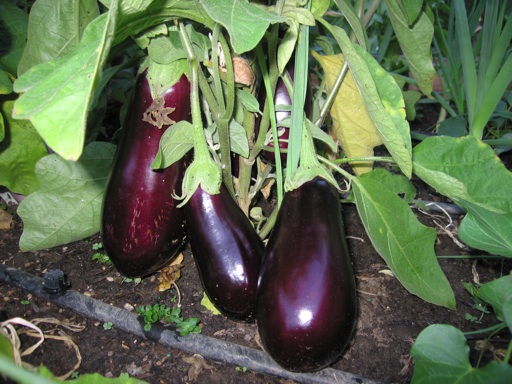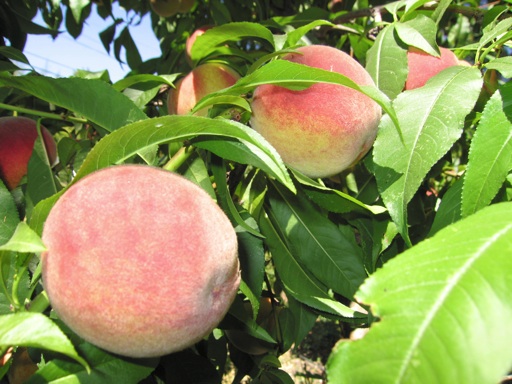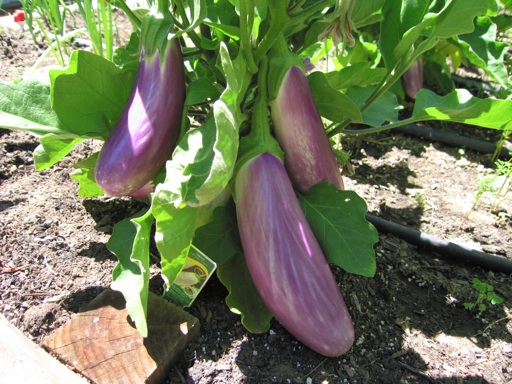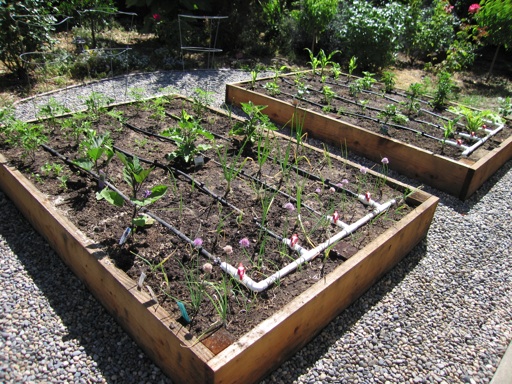Archive for the 'Tomatoes' Category



This year, I planted only four tomato plants. The varieties I selected were Big Beef, Beefsteak, Beefmaster, and San Marzano (a plum tomato). I planted nursery transplants in mid-March to give them a head start on the growing season. They grew quickly even in our mild early spring weather, when the highs were only in the 60s. By mid-July, they had ripe tomatoes.
Our Beefmaster tomato plant started to die before it produced many tomatoes. But our other three tomato plants have produced hundreds of tomatoes. Two weeks ago, I harvested all the tomatoes shown on the table in the above picture. We couldn’t possibly eat all of these tomatoes before they went bad, so I canned most them.
The San Marzano tomatoes are ideal for canning. The other varieties are often eaten fresh, but I decided to can all four varieties. I just canned them as plain tomato slices, which is a lot less work than making a tomato sauce first and then canning the sauce like I did in previous years.
I began by slicing each tomato into sections small enough to fit into the jars. Then, I removed the tomato seeds using my fingers, although I wasn’t able to remove them all. That part alone was at least 90 minutes of work for 2 people. I didn’t bother to remove the tomato skins. Removing the skins requires an additional step that is a lot of extra work for so many tomatoes. I don’t mind tomato skins in my food. I usually end up pureeing the canned tomatoes before I use them in a recipe anyway. But I don’t like lots of seeds floating around in the jars.
After cooking the sliced and de-seeded tomatoes in boiling water for 5 minutes using a hot pack method, I packed each jar with tomatoes and some lemon juice for extra acidity leaving about 1 inch of space from the top. Then I processed the jars in a pressure cooker canner at 10 psi for about 25 minutes. I filled about 18 jars with about 3/4 of the tomatoes. (if you use a pressure cooker, be sure to follow the product directions of use carefully). Tomatoes canned this way can be stored for up to a year at room temperature. I used this same technique last summer to can tomato slices. We used our canned tomatoes for more than 6 months before we ran out of them.
August 25 2012 | Tomatoes | Comments Off on Canning Tomatoes
Even as summer begins to wind down, the vegetables growing in our 4 raised beds are still producing an over-abundance of vegetables. In fact, I have spent most of the weekends in the past month canning tomatoes and peaches. I just finished another batch of tomato sauce today, and the tomatoes keep on coming. We have harvested close to 300 tomatoes from the plants shown in this picture.

And we have barely begun to harvest the San Marzano tomatoes that are growing in another raised bed (see the next picture below). These tomatoes got off to a late start, because we planted them by seed at home and then set them outside in mid-May. We decided to grow San Marzano tomatoes after we heard Anne Burrell rave about them on the Food Network. We couldn’t find them as transplants, so we bought a seed packet.

We have also had a lot of luck with eggplants this year. We are growing the lavender touch, black beauty, and New York varieties that we purchased as transplants from a nursery. We are also growing the Japanese long variety, which we started by seed indoors. I was curious to see if we could get our own seedlings to grow as well as the eggplant transplants that are sold in nurseries. I suspect that most vegetable transplants sold in nurseries are sown in the winter and grown in a greenhouse, giving them a big head start on the growing season.
Our Japanese long eggplants are much smaller than the other varieties we have, but they are growing surprisingly well despite the fact that they were much smaller than the other varieties when we set them outside into the ground. Here is a picture that I took yesterday of our New York eggplant, which has a few big fat eggplants that look very similar to black beauty.

We are also growing several varieties of peppers this year. We have jalapeno, habanero, serrano, Thai, de-arbol, and various types of bell peppers. In general, the hot peppers are growing better than the bell peppers. This is the fourth year in a row I have planted bell peppers. The plants are not vigorous growers, at least in our garden. Each plant only produces a few bell peppers, and the fruit is usually small.
The hot peppers are growing better. We planted all of our peppers as transplants that we bought from a nursery, except the habanero peppers. We started those by seed ourselves indoors in the spring along with the eggplants and San Marzano tomatoes. I was skeptical that we would have any success trying to grow peppers by seed ourselves, but we decided to give it a try as an experiment. After a slow start, our habanero peppers started growing very well at the start of summer, and they are now producing several small peppers. I am amazed they have grown as well as they have.
Below are pictures of our habanero, serrano and de-arbol peppers, respectively. The de-arbol pepper is a very attractive ornamental plant, having several red chilis surrounding its green leaves. In fact, our plants have so many hot peppers that we are not sure what to do with them. I am considering trying to dry them, which might be one of my next projects.



September 12 2010 | Eggplant and Peppers and Tomatoes | Comments Off on Late Summer Vegetables
In the past few weeks, I have canned peaches, tomatoes, and cucumbers from our garden. Last weekend, I made more tomato sauce with our garden tomatoes. I have made a total of about 15 jars of tomato sauce over the past month. I also canned about 40 peaches from our O’Henry peach tree last weekend. Here is a photo of the bottled tomato sauce, cucumber pickles, and peaches sitting on our kitchen shelf.

In general, low acid foods need to be canned using a pressure cooker. I canned the tomato sauce using a pressure cooker, because I put low acid vegetables in it including celery, onions, and carrots. High acid foods can be canned by boiling them in water. I canned the peaches and the cucumbers using the boiling water canning method. The recipe for the cucumber pickles called for a lot of added vinegar, which raised their acidity level enough to obviate the need to can them with a pressure cooker.
I have harvested about 150 tomatoes in the past month from only 3 of our tomato plants. The first picture is just the harvest from last weekend. The second picture shows some of our ripe tomatoes on the vines.


I gave several of our tomatoes away, and I canned the remainder. Canned fruits and vegetables are supposed to last for at least a year. Canning is not only a great way to preserve a large harvest for long period of time, but it also allows you to preserve recipes with very flavorful ingredients. Many store bought tomatoes and peaches are picked before they are ripe and do not fully sweeten or ripen sitting on a store shelf. Because I picked our tomatoes when they were fully ripe, our tomato sauce has a nice sweetness and flavor to it that I don’t think can be replicated using unripe tomatoes.
This is the first year I have canned home grown peaches. I grew up eating store bought canned peaches for breakfast, and I never liked those. But I decided to try canning some of our home grown peaches this year, because our O’Henry tree had nearly 100 peaches on it, and we couldn’t eat them all fresh before they spoiled. We first sliced and boiled the peaches in a medium syrup for a few minutes, bottled them with the syrup, and then processed the bottles in boiling water. I think the resulting product is tastier than the canned peaches I grew up eating. They are sweeter and have a better flavor and texture.
Here are some pictures of our O’Henry peach tree that I took before we picked the bulk of the fruit.


August 28 2010 | Cucumbers and Peaches/Nectarines and Tomatoes | Comments Off on Canning Garden Fruits
Yesterday, I picked a few dozen of our ripe tomatoes. We are growing 4 varieties of tomatoes this year: one Early Girl, one Big Beef, one Champion, and about a dozen San Marzano tomatoes. The last two years we had a substantial harvest of tomatoes from just one Early Girl tomato plant and one Big Beef tomato plant. This year is the first time we have grown Champion and San Marzano. Most of the tomatoes I picked yesterday were from our Early girl and Big Beef plants.
Here is picture of some of our early girl tomatoes on the vine.

We still have about a few hundred more green tomatoes on the vines, not including the San Marzano tomatoes which just started blooming and fruiting. This is a photo of yesterday’s harvest, including tomatoes, onions, and a carrot.

Today, I made a spicy tomato sauce with the carrot, the onions, the tomatoes, and celery from a grocery store. Then, I bottled the sauce and processed it in our pressure cooker for about 45 minutes. Vegetables such as carrots, celery, and tomatoes are considered low acid. Therefore, they need to be processed at a higher temperature than the boiling point of water (212 degrees F) if they are going to be stored at room temperature for an extended period. A pressure cooker is designed to raise its internal temperature up to about 240 degrees.
Our eggplants are finally producing their first eggplant fruits. We are growing about a dozen eggplants this year from seeds and transplants we bought from a local nursery. I set out the transplants in late April and May, but they really didn’t start growing and blooming until about early June when the warmer summer weather began. We are growing the Japanese long, lavender touch, New York, and black beauty varieties of eggplants. This is a photo of one of our lavender touch eggplants. I really like this variety, because the color of the fruit is so beautiful and the flesh is creamier and moister than some of the darker varieties.

We are also growing cucumbers in our vegetable garden this year. We planted a variety called Straight Eight cucumbers by seed. I had planted some of the cucumber seeds indoors in March, but when I transplanted those seedlings outside in April they died even though we didn’t have any freezing weather. I think they died because I didn’t harden them off to the outdoor sun exposure and temperatures.
After that experience, I planted the remaining cucumber seeds directly in one of our raised beds in late April. Most of those seeds sprouted within about a week and grew quickly. Now we have about 20 medium and small cucumbers (4″-8″) from about 20 plants. This is a photo of few of them.

Last weekend, I tried pickling one of our cucumbers in a simple brine solution of water, salt, sugar, and dill spice. I cooked the cucumber slices in the brine for about 15 minutes. They tasted as good as the dill pickles that are bottled and sold commercially. Next weekend, I am planning on pickling and canning the rest of our cucumbers.
August 01 2010 | Cucumbers and Eggplant and Tomatoes | Comments Off on Vegetable Garden Harvest
In March, we added two more raised beds in our backyard. We now have four raised beds that we are growing vegetables in. This year, we are growing tomatoes, potatoes, pole beans, peppers, eggplants, onions, basil, strawberries, cilantro, corn, zucchini, carrots, and cucumbers in our four raised beds. Although we haven’t harvested any vegetables yet, some of our vegetable plants are growing better than others.
Last October, I harvested seeds from dried up bean pods on our pole bean plants. I stored those seeds in a plastic bag over the winter and then planted the seeds in mid-March. Below is a picture of our pole beans today. In nearly 3 months, they have completely covered the fence I built for them last year.

In my experience, pole beans have been really easy to grow by seed and very prolific producers. Nearly all of the seeds sprout without any stratification. And once the beans sprout, they grow quickly with minimal care and little or no fertilizer (at least in our soil which is amended with compost). Although snails and slugs will eat them if they are not protected somehow. Every year that we have grown pole beans (for about the past 4 years), they have produced more beans than we could eat.
Another plant we have had a lot of luck growing is tomatoes. We planted three tomato transplants (early girl, big beef, and champion) in March that we bought from a local nursery. They were about 4 inches tall at the time. They have grown very quickly over the past 3 months, even though the weather here has been much wetter and cooler than average. As shown in the next picture, they have already grown to completely fill their cages.

We also planted San Marzano tomatoes by seed indoors a few months ago. Growing tomatoes by seed is a first for us. Nearly, all of the tomato seeds sprouted, but as soon as I transplanted the first batch of seedlings outside in early May, they died. The remaining batches of tomato seedlings I “hardened off” by gradually exposing them to direct sunlight and the outside temperature a few hours a day. After hardening off for about 2 weeks, I planted the remainder of the seedlings outside in our new raised beds. The tomato seedlings I hardened off survived and are looking better, although they are only about 6 inches high now.
Of course, one of the advantages of growing plants by seed is access to a larger number of varieties, many of which are not easy to find as transplants. San Marzano tomatoes are supposed to be great sauce tomatoes. The next pictures shows the two new raised beds we just added in our yard. The San Marzano tomatoes are growing on the left side of the bed in the foreground.

Some of the plants that we haven’t had much luck with this year are onions and leeks. I planted white onion sets, shallot sets, and leek transplants in one of our raised beds in March. The onions and leeks are growing on the right side of the bed in the foreground in the above picture. Although the onions and shallots sprouted, they haven’t grown much, and many of their leaves are turning yellow. The leeks haven’t grown at all since I planted them. I don’t have any idea why they haven’t grown well. But I tend to think that part of the fun of growing is taking a chance on growing new plants and that often means some of those plants don’t end up growing well.
Potatoes are another new plant we added to our garden this year. I planted yukon gold potatoes, which I ordered online as potato sets. I also planted white potato sets, which I purchased from a local nursery. The yukon gold potatoes look wonderful. They have already grown to about two feet tall and have really filled in the space around them (see picture below). The white potatoes sprouted, but they didn’t grow nearly as much as the yukon gold potatoes, so I ended up removing most of the white potatoes to make room for other plants.

June 13 2010 | Beans and Onions and Potatoes and Tomatoes | Comments Off on Vegetable Garden Successes and Misses
Next »





















